Related Research Articles

Guinevere, also often written in Modern English as Guenevere or Guenever, was, according to Arthurian legend, an early-medieval queen of Great Britain and the wife of King Arthur. First mentioned in popular literature in the early 12th century, nearly 700 years after the purported times of Arthur, Guinevere has since been portrayed as everything from a fatally flawed, villainous and opportunistic traitor to a noble and virtuous lady. Many records of the legend also feature the variably recounted story of her abduction and rescue as a major part of the tale.

Lancelot du Lac, also written as Launcelot and other variants, is a character in some versions of Arthurian legend where he is typically depicted as King Arthur's close companion and one of the greatest Knights of the Round Table. In the French-inspired Arthurian chivalric romance tradition, Lancelot is an orphaned son of King Ban of the lost kingdom of Benoic, raised in a fairy realm by the Lady of the Lake. A hero of many battles, quests and tournaments, and famed as a nearly unrivalled swordsman and jouster, Lancelot becomes the lord of the castle Joyous Gard and personal champion of Arthur's wife, Queen Guinevere, despite suffering from frequent and sometimes prolonged fits of madness. But when his adulterous affair with Guinevere is discovered, it causes a civil war that, once exploited by Mordred, brings an end to Arthur's kingdom.

Mordred or Modred is a figure in the legend of King Arthur. The earliest known mention of a possibly historical Medraut is in the Welsh chronicle Annales Cambriae, wherein he and Arthur are ambiguously associated with the Battle of Camlann in a brief entry for the year 537. Medraut's figure seemed to have been regarded positively in the early Welsh tradition and may have been related to that of Arthur's son.
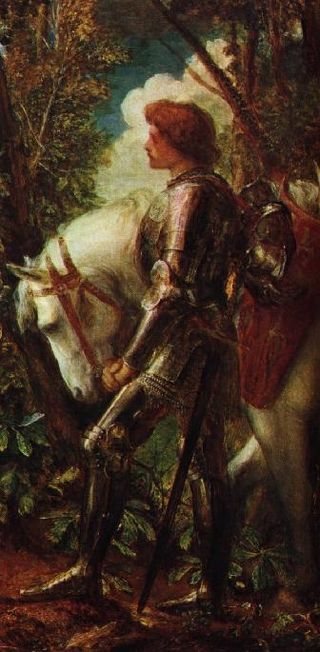
Galahad, sometimes referred to as Galeas or Galath, among other versions of his name, is a knight of King Arthur's Round Table and one of the three achievers of the Holy Grail in Arthurian legend. He is the illegitimate son of Sir Lancelot du Lac and Lady Elaine of Corbenic and is renowned for his gallantry and purity as the most perfect of all knights. Emerging quite late in the medieval Arthurian tradition, Sir Galahad first appears in the Lancelot–Grail cycle, and his story is taken up in later works, such as the Post-Vulgate Cycle, and Sir Thomas Malory's Le Morte d'Arthur. In Arthurian literature, he replaced Percival as the hero in the quest for the Holy Grail.

The Lady of the Lake is a name or a title used by several either mermaid or mermaid-like but human enchantresses in the Matter of Britain, the body of medieval literature and mythology associated with the legend of King Arthur. She plays several important roles in many stories, including providing Arthur with the sword Excalibur, eliminating Merlin, raising Lancelot after the death of his father, and helping to take the dying Arthur to Avalon. Different sorceresses known as the Lady of the Lake appear concurrently as separate characters in some versions of the legend since at least the Post-Vulgate Cycle and consequently the seminal Le Morte d'Arthur, with the latter describing them as a hierarchical group, while some texts also give this title to either Morgan or her sister.

The Knights of the Round Table are the legendary knights of the fellowship of King Arthur that first appeared in the Matter of Britain literature in the mid-12th century. The Knights are an order dedicated to ensuring the peace of Arthur's kingdom following an early warring period, entrusted in later years to undergo a mystical quest for the Holy Grail. The Round Table at which they meet is a symbol of the equality of its members, who range from sovereign royals to minor nobles.
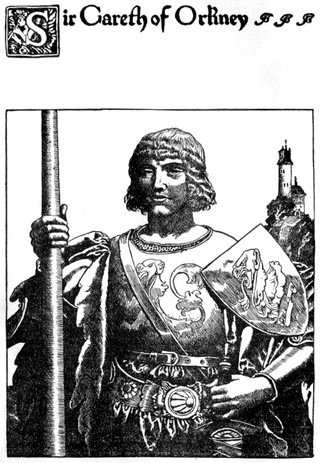
Gareth is a Knight of the Round Table in Arthurian legend. He is the youngest son of King Lot and Queen Morgause, King Arthur's half-sister, thus making him Arthur's nephew, as well as brother to Gawain, Agravain and Gaheris, and either a brother or half-brother of Mordred. Gareth is particularly notable in Le Morte d'Arthur, where one of its eight books is named after and largely dedicated to him, and in which he is also known by his nickname Beaumains.
Maleagant is a villain from Arthurian legend. In a number of versions of a popular episode, Maleagant abducts King Arthur’s wife, Queen Guinevere, necessitating her rescue by Arthur and his knights. The earliest surviving version of this episode names the abductor Melwas; as Maleagant, he debuts as Lancelot's archenemy in Chrétien de Troyes' French romance Lancelot, the Knight of the Cart. However, all surviving versions seem to be later adaptations of a stock narrative of significantly earlier provenance.
This is a bibliography of works about King Arthur, his family, his friends or his enemies. This bibliography includes works that are notable or are by notable authors.

The Knight of the Sacred Lake is a historical fantasy novel by Rosalind Miles. It was first published in 2000 by Simon & Schuster in the UK followed by Crown Books in the US. The book is a retelling of the Arthurian legend and follows the lives of Queen Guinevere, consort of King Arthur and her struggles with the king's nephews Agravain and Gawain; the queen is torn between her love for her husband, her land, and her lover, Lancelot. The book was part of a series, The Guinevere Novels, and was followed by The Child of the Holy Grail. Reviewing the book, Publishers Weekly described it as "a lush, feminist take on the English epic".
Guinevere is a 1994 Lifetime television film based on the Arthurian legend. The story is told from Queen Guinevere's point of view, presenting her as the driving force behind the success of Camelot. It was adapted from author Persia Woolley's Guinevere trilogy of novels: Child of the Northern Spring, Queen of the Summer Stars, and Guinevere: The Legend in Autumn.

Queen of Camelot is an Arthurian-legend based novel shown through the viewpoint of Queen Guinevere. It is a combination of two of Nancy McKenzie's previous books The Child Queen and The High Queen. She states in the foreword that she originally intended the novels to be combined, but they were split at the time of publication because of their length.
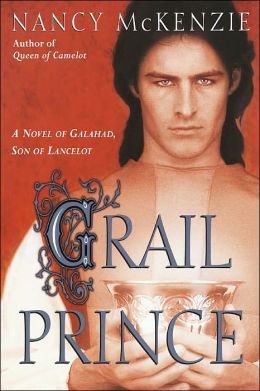
Grail Prince, a 2003 novel by American author Nancy McKenzie written in the tradition of Arthurian legends, recounts a version of Galahad's quest for the Holy Grail. The novel is a sequel to McKenzie's Queen of Camelot (2002).
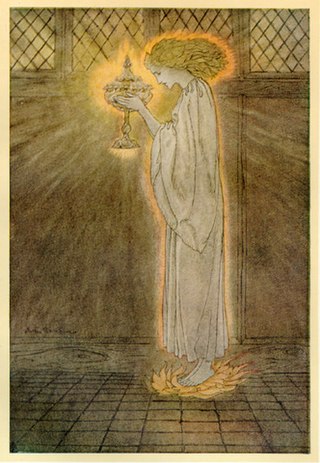
Elaine or Elizabeth, also known as Amite, and identified as the "Grail Maiden" or the "Grail Bearer", is a character from Arthurian legend. In the Arthurian chivalric romance tradition from the Vulgate Cycle, she is the daughter of the Fisher King, King Pelles of Corbenic, and the mother of Galahad by Lancelot, whose repeated rape by her results in his descent into madness. She should not be confused with Elaine of Astolat, a different woman who too fell in love with Lancelot.
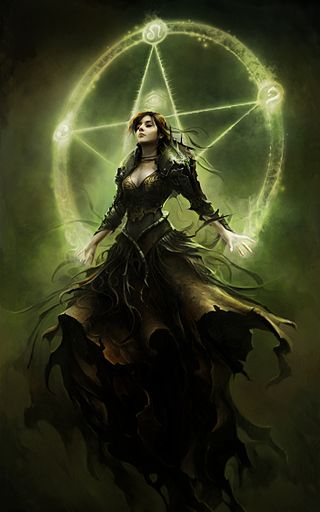
The Matter of Britain character Morgan le Fay has been featured many times in various works of modern culture, often but not always appearing in villainous roles. Some modern stories merge Morgana's character with her sister Morgause or with aspects of Nimue. Her manifestations and the roles given to her by modern authors vary greatly, but typically she is being portrayed as a villainess associated with Mordred.

Daughter of Tintagel is a series of historical fantasy novels by British writer Fay Sampson. It tells the story of the life of Arthurian legend character Morgan le Fay, presented through an oral history narrative from her early childhood to her disappearance. It was originally published as five books between 1989 and 1992, followed by an omnibus edition in 1992. The series was re-published in 2005 as Morgan le Fay.
Sebile, alternatively written as Sedile, Sebille, Sibilla, Sibyl, Sybilla, and other similar names, is a mythical medieval queen or princess who is frequently portrayed as a fairy or an enchantress in the Arthurian legend and Italian folklore. She appears in a variety of roles, from the most faithful and noble lady to a wicked seductress, often in relation with or substituting for the character of Morgan le Fay. Some tales feature her as a wife of either King Charlemagne or Prince Lancelot, and even as an ancestor of King Arthur.

Unholy Grail is a horror comic book series written by Cullen Bunn and illustrated by Mirko Colak, published by American company AfterShock Comics. The colorist is Maria Santaolalla, and the letterer is Simon Bowland.
Guiomar is the best known name of a character appearing in many medieval texts relating to the Arthurian legend, often in relationship with Morgan le Fay or a similar fairy queen type character.
References
- 1 2 3 4 5 6 "Nancy McKenzie". Contemporary Authors Online. 1 January 2004. Archived from the original on 10 June 2014. Retrieved 6 January 2011.(subscription required)
- 1 2 "Author Spotlight: Nancy McKenzie". Random House . Retrieved 5 January 2011.
- 1 2 Ashley, Michael; Mike Ashley (2005). The Mammoth Book of King Arthur. New York: Carroll & Graf Publishers. p. 534. ISBN 9780786715664.
- 1 2 3 "Interview with Nancy McKenzie". WaldenBooks. Archived from the original on 22 May 2008. Retrieved 5 January 2011.
- 1 2 Busby, Keith; Roger Dalrymple (2005). Arthurian Literature XXII. Cambridge: D.S. Brewer. p. 135. ISBN 9781843840626.